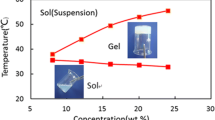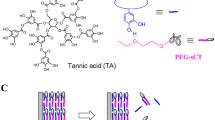Abstract
Purpose. Stimuli-sensitive polymers are suitable candidates for oral peptide drug delivery vehicles since they will prevent gastric degradation in the stomach while providing a controlled release of a peptide drug such as calcitonin later. The purpose of this study was to fabricate polymeric beads from pH/temperature sensitive linear terpolymers (poly(N-isopropylacrylamide-co-butylmethacrylate-co-acrylic acid)) and load them with a peptide drug, human calcitonin, which was dissolved in aqueous phase.
Methods. The polymeric beads were formed by solubilizing a cold, aqueous solution of temperature sensitive polymer with human calcitonin. This solution was added dropwise into an oil bath kept at a temperature above the LCST of a polymer, precipitating polymer and entrapping the peptide. The quantity and the physical state of the peptide were analyzed by reverse-phase HPLC, CD and FTIR and its biological activity after loading was determined in vivo.
Results. The loading efficiency and stability of human calcitonin into the polymeric beads was studied as a function of pH and ionic strength of the loading buffer and temperature of the oil bath. Final optimal loading conditions were 20 mM glycine/HCl buffer, pH 3.0 containing 0.15 M NaCl as a dissolution medium and 23°C as the oil bath temperature. Loading and release of human calcitonin were also studied as a function of acrylic acid content in the terpolymers. As the acrylic acid content increased from 0 to 10 mol %, the loading efficiency and stability of calcitonin improved significantly. The same trend was observed for the quantity of released calcitonin. In vivo biological activity of the released hormone was preserved.
Conclusions. The results showed that the beads made of the polymers with high content of acrylic acid (most hydrophilic) provided better loading, stability and release of human calcitonin. The designed beads represent a new potential system for oral delivery of calcitonin and other peptides.
Similar content being viewed by others
REFERENCES
M. Azria. The Calcitonins, Physiology and Pharmacology, Karger, Basel, 1989.
K. H. Antonin, V. Saano, P. Bieck, J. Hastewell, R. Fox, P. Lowe and M. Mackay. Colonic absorption of human calcitonin in man. Clin. Sci. 83:627–631 (1992).
G. Golomb, A. Avramoff and A. Hoffman. A new route of drug administration: Intrauterine delivery of insulin and calcitonin. Pharm. Res. 10:828–833 (1993).
B. H. P. Li and G. C. Y. Chiou. Systemic administration of calcitonin through ocular route. Life Sci. 50:349–354 (1992).
S. Kobayashi, S. Kondo and K. Juni. Study on pulmonary delivery of salmon calcitonin in rats: Effects of protease inhibitors and absorption enhancers. Pharm. Res. 11:1239–1243 (1994).
Y. Nakada, M. Miyake and N. Awata. Some factors affecting the vaginal absorption of human calcitonin in rats. Int. J. Pharm. 89:169–175 (1993).
K. Overgaard, M. A. Hansen, K. Dirksen and C. Christiansen. Rectal salmon calcitonin for the treatment of postmenopausal osteoporosis. Calcif. Tissue Int. 51:184–188 (1992).
C. Gennari, S. Gonnelli, G. Monaci, M. S. Campagna and B. Franci. Pharmacodynamic activity of synthetic salmon calcitonin in osteoporotic patients: Comparison between rectal and intramuscular administration; Pilot study. Curr. Ther. Res. 53:301–308 (1993).
W. A. Lee, R. D. Ennis, J. P. Longenecker and P. Bengtsson. The bioavailability of intranasal salmon calcitonin in healthy volunteers with and without a permeation enhancer. Pharm. Res. 11:747–750 (1994).
K. C. Lee, E. E. Soltis, P. S. Newman, K. W. Burton, R. C. Mehta and P. P. DeLuca. In vivo assessment of salmon calcitonin sustained release from biodegradable microspheres. J. Control. Rel. 17:199–206 (1991).
A. J. Millest, J. R. Evans, J. J. Young and D. Johnstone. Sustained release of salmon calcitonin in vivo from lactide: Glycolide copolymer depots. Calcif. Tissue Int. 52:361–364 (1993).
Ch. Tasset, N. Barette, S. Thysman, J. M. Ketelslegers, D. Lemoine and V. Préat. Polyisobutylcyanoacrylate nanoparticles as sustained release system for calcitonin. J. Control. Rel. 33:23–30 (1995).
P. J. Lowe and C. S. Temple. Calcitonin and insulin in isobutylcyanoacrylate nanocapsules: Protection against proteases and effect on intestinal absorption in rats. J. Pharm. Pharmacol. 46:547–552 (1994).
A. Ariën, N. Henry-Toulmé and B. Dupuy. Calcitonin-loaded liposomes: Stability under acidic conditions and bile salts-induced disruption resulting in calcitonin-phospholipid complex formation. Biochim. Biophys. Acta. 1193:93–100 (1994).
Y. H. Bae, T. Okano and S. W. Kim. Insulin permeation through thermo-sensitive hydrogels. J. Control. Rel. 9:271–279 (1989).
Y. H. Bae, T. Okano and S. W. Kim. “On-off” thermocontrol of solute transport. II. Solute release from thermosensitive hydrogels. Pharm. Res. 8:624–628 (1991).
S. W. Kim, Y. H. Bae and T. Okano. Hydrogels: Swelling, drug loading, and release. Pharm. Res. 9:283–290 (1992).
G. Chen and A. S. Hoffman. Graft copolymers that exhibit temperature-induced phase transitions over a wide range of pH. Nature 373:49–52 (1995).
R. Yoshida, K. Uchida, Y. Kaneko, K. Sakai, A. Kikuchi, Y. Sakurai and T. Okano. Comb-type grafted hydrogels with rapid de-swelling response to temperature changes. Nature 374:240–242 (1995).
H. Feil, Y. H. Bae and S. W. Kim. Mutual influence of pH and temperature on the swelling of ionizable and thermosensitive hydrogels. Macromolecules 25:5528–5530 (1992).
H. Feil, Y. H. Bae, J. Feijen and S. W. Kim. Effect of comonomer hydrophilicity and ionization on the lower critical solution temperature of N-isopropylacrylamide copolymers. Macromolecules 26:2496–2500 (1993).
Y. H. Kim, Y. H. Bae and S. W. Kim. pH/Temperature—sensitive polymers for macromolecular drug loading and release. J. Control. Rel. 28:143–152 (1994).
L. Hovgaard, E. J. Mack and S. W. Kim. Insulin stabilization and GI absorption. J. Control. Rel. 19:99–108 (1992).
M. Baudyš, D. Mix and S. W. Kim. Stabilization and intestinal absorption of human calcitonin. J. Control. Rel. In press.
T. Arvinte, A. Cudd and A. F. Drake. The structure and mechanism of formation of human calcitonin fibrils. J. Biol. Chem. 268:6415–6422 (1993).
Author information
Authors and Affiliations
Rights and permissions
About this article
Cite this article
Serres, A., Baudyš, M. & Kim, S.W. Temperature and pH-sensitive Polymers for Human Calcitonin Delivery. Pharm Res 13, 196–201 (1996). https://doi.org/10.1023/A:1016026711364
Issue Date:
DOI: https://doi.org/10.1023/A:1016026711364




